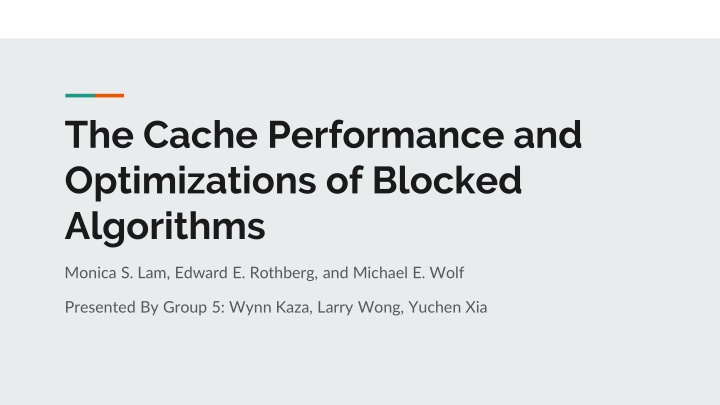
Optimizing Cache Performance for Blocked Algorithms
Discover the significance of cache performance in optimizing blocked algorithms through insights on cache misses, matrix multiplication, and types of cache misses. Explore strategies to enhance cache utilization and boost algorithm efficiency.
Download Presentation

Please find below an Image/Link to download the presentation.
The content on the website is provided AS IS for your information and personal use only. It may not be sold, licensed, or shared on other websites without obtaining consent from the author. If you encounter any issues during the download, it is possible that the publisher has removed the file from their server.
You are allowed to download the files provided on this website for personal or commercial use, subject to the condition that they are used lawfully. All files are the property of their respective owners.
The content on the website is provided AS IS for your information and personal use only. It may not be sold, licensed, or shared on other websites without obtaining consent from the author.
E N D
Presentation Transcript
The Cache Performance and Optimizations of Blocked Algorithms Monica S. Lam, Edward E. Rothberg, and Michael E. Wolf Presented By Group 5: Wynn Kaza, Larry Wong, Yuchen Xia
Outline Motivation Algorithm Results Further Experiments Commentary
Why is cache performance important? Faster processor speed, but limited by memory speed Cache models are not optimized for heavy numerical code such as matrix multiplication
What are Blocked Algorithms? Goal: Reduce cache misses How: Make full use of data in cache before evicting
Matrix Multiplication (1) for row := 1 to N do (2) for k := 1 to N do Given: r = X[row][k] X := NxN matrix (3) for col := 1 to N do Y := NxN matrix Z[row][col] += r*Y[k][col] X Z := NxN matrix Z Y Goal: Z = XY
Blocked Matrix Multiplication Z X Y Given: Block size BxB for kk := 1 to N by B do for jj := 1 to N by B do for i := 1 to N do for k := kk to min(kk+B-1, N) do B Wide B Wide BxB Block r = X[i][k]; for j := jj to min(jj+B-1, N) do Z[i][j] += r*Y[k][j];
Types of Cache Misses Intrinsic Misses Cross Interference Misses Self Interference Misses
Types of Cache Misses Intrinsic Misses Data that has never been read E.g., loading from X at start Cross Interference Misses Self Interference Misses
Types of Cache Misses Intrinsic Misses Cross Interference Misses Different variables evict each other from the cache E.g., loads from Z and Y Self Interference Misses
Types of Cache Misses Intrinsic Misses Cross Interference Misses Self Interference Misses Important! Data from the same variable evicts itself E.g., loads from each row of matrix Y evicts older loads
Matrix Multiplication Cache Model N = Array dimension B = Block dimension C = Cache size Si(Y) = self interference factor for variable Y Intrinsic Misses Self Interference Misses Cross Interference Misses
Why Constant Block Factor Doesnt Work Easiest Assumption - Take square root of cache size for block factor New Foresight - Increasing the block factor degrades performance significantly
How do Misses Fit In? What's B0 - - B0is critical blocking factor All values greater than B0leads to significant self interference Changes significant even for small differences in matrix size & same cache size -
N = 293 Using same cache size! N = 300
How Self Interference Happens X B1 X B2
Direct Mapped Cache 0xFFF Conflict! 0x022004 X1 0x022008 0x004 0x054004 X2 0x054008 0x000
Dynamic Blocking Algorithm N = Matrix Size C = Cache Size addr = addr + C Di= addr / N False return min(maxWidth, Dj) Dj= abs((addr % N) - N / 2) True If (Di>= min(maxWidth, Dj)
Big Idea of Algorithm Runtime: O(N / C) If (&Y[i, j] = &Y[i +Di, j + Dj] % (Cache Size)) Then (B0can t be larger than max(Di, Dj))
Results B0is sensitive to small changes in matrix dimension N Optimal fixed block size is quite small B0is large, diminishing return for choosing larger block sizes B0is small, serious self interference for moderate block sizes
Cross interference limits the optimal blocking factor to (C/2) Self interference dominates if B0< (C/2) Otherwise cross interference is the critical part
Further Experiments - Set Associativity Average miss rate remain relatively flat as block size increases Larger critical blocking factors Fraction of cache used remains small but larger than direct-mapped cache Lower average miss rate
Line Size Line size of m words >> reduce the miss rate by m ideally Utilize spatial locality Smaller reduction on miss rate in practical Cache line misalignment
Commentary One of the first papers to look at cache interference (theoretically and experimentally), and it s relationship with stride and block size for numerical calculations However: A lot of graphs mention Misses/Ideal but hand-wavey on the definition of ideal Formulas are unintuitive and unmotivated Mention Cross Interference, but it s not explained really well. Makes assumption about location of reuse Models cannot make good predictions in complex situations






















